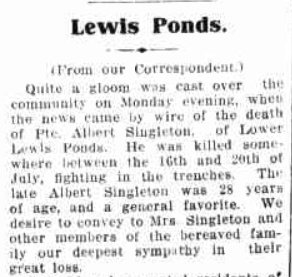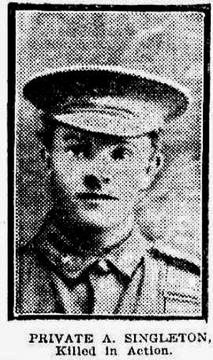
Albert Leslie SINGLETON
Eyes blue, Hair light brown, Complexion fair
From the historic gold fields of NSW
With thanks to family member Rob Cunneen for permission to use the story published on the Orange City Council wiki site (Albert Leslie Singleton) as the heart of this story of Fromelles soldier, Albert Singleton.
DNA search: Do you know Albert’s SINGLETON relatives here or in England?
He is one of the Fromelles soldiers still missing with events surrounding his death reported in evidence to the Red Cross including.
-- “We were in German second line at Fromelles. “
-- “…killed in a German trench”
-- “He fell back dead in an advanced position, land left in German hands.”
Albert was in a location likely to have been buried in the mass graves. As at November 2019, 166 of the 250 in the Fromelles mass graves have been identified through family DNA. We are still seeking suitable DNA for Albert.
While one mt DNA donor has donated DNA, a second is needed.
But importantly, none of Albert’s immediate family in Australia carry the Y DNA that we are seeking. Thus, we need assistance to locate family connected to the Singleton grandparents and great grandparents who came from the district around Whitehaven, Cumberland, UK. This latter part of the search is specific to males named Singleton. See search results and the DNA box at the end of the story for more detail.
Albert Singleton was born in 1887, the youngest of eight, in Lewis Ponds, just to the east of the town of Orange in New South Wales. His parents were Thomas John Isaac Singleton 1818-1907 and Margaret Cunneen 1847-1929. Of their eight children, two unnamed boys died around birth and Walter died aged 3 which left five children surviving to adulthood – John 1874, Maud 1875, Arthur 1879, Lilly 1884 and Albert 1887
According to his death certificate, Albert’s father, Thomas, was born Whitehaven, Cumberland in about 1818. His mother, Margaret Cunneen, was born about 1847 in Ireland – in Kilnasoolagh, County Clare. They married in Orange in 1872.
We presume that Thomas began as a digger on the goldfields at Lewis Ponds – he certainly had a gold lease – and stayed on to run a business, being described as a hotel and storekeeper at the time of his marriage and for many years thereafter.
A newsy article about a trip to Lewis Ponds in 1874 gives an insight into the life of the area at the time, including mention of the Singleton family:
“….Lewis Ponds, which is, without doubt, a fine open country, and a most healthy and delightful spot. I was surprised to see on this gold-field, which is not the case on many, splendid well stocked gardens, which are cultivated during the intervals of other work. The houses of the miners are also very comfortable-looking habitations, and cleanliness, which is “next to godliness" is the order of the day on this green valley.
……..The population of this place number over 200, and are about petitioning for a post-office. At present they labour under the disadvantage of a trip to the Ophir, distant five miles.
……I was also informed that a school is much wanted, and that a petition has just started for signature, to apply to the Council for aid. I observed a good many healthy-looking children running about, able for school. I wish them every success in as this - “Tis education forms the common mind, just as the twig is bent the tree's inclined”
There are two stores, one kept by Mr Whiting, the other by Mr Singleton; the latter does the principal business, as he has a " pub", and butcher's shop in connection - a very neat clean compact brick building, and outhouses, everything in its place. The hostess is a very civil and obliging business woman. I was told that the servant girl went for water, the other day, and brought up 2 dwts.18grs. of coarse gold, a rich bucket of water!
A Flytrap attracted my notice, a very simple and effective trap, Mr Singleton's own design, made out of a common deal, fixed in the window, in the shape of a horizontal V, apex out, upper part of window darkened, all blow flies in the store go into this, and cannot get out, and die very soon.”
Singleton’s “pub”, store and butchery described in the article above was run by the family from 1872 until 1920. Because it was a substantial brick structure, the building still survives, but is now called Wildwood Cottage. The rest of the old 19th century village of Lower Lewis Ponds has disappeared.
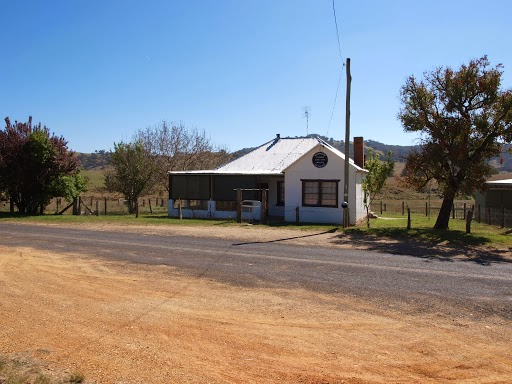
Despite his father having been a board member of the local school at Ophir, Albert was educated in Sydney at Stanmore and Petersham Public Schools and at the Christian Brothers school at Newtown. Probably Albert boarded with his aunt Cecilia Brady, who lived in Newtown and Petersham during the years Albert was at school. His Brady cousins, Reg and Vic, would have gone to the same schools.
In 1907 his father died, and Albert and his older brother Arthur ran the store. The district of Lewis Ponds was in decline as people moved away from the old gold fields. Albert left in 1913 to make his own way in the world, working firstly in Murrurundi and then in Gundagai as head grocer for George F. Grill’s Railway Store. He had prior experience from the family store.
Albert goes to war
With the awful news from Gallipoli through 1915, there was a surge of volunteers enlisting in the AIF. So, on 3 September 1915, Albert Singleton (4316) with his mate from Gundagai, Leo Boyton (4150), enlisted in the Army at Cootamundra. Albert had tried to sign up earlier at Gundagai but had been rejected by the doctor.
The two mates joined the 1st Battalion, 13th Reinforcement as privates, meeting up with Taree recruit, Private Jack Edward Smith (4311) (aka Lionel Schmitzer). On 20 December 1915, the three musketeers – Privates Singleton, Boyton and Smith - embarked upon HMAT Aeneas for Egypt.
A letter from Albert written from Port Suez was published in the local Gundagai newspaper. Albert described aspects of their 26- day non-stop trip as:
“not all beer and skittles but taking one thing with another, it is not altogether too bad.” Their bill of fare was a little below expectations, but they made their own amusements to pass the time including concerts, euchre tournaments, boxing and other sports. Port Suez was described as “not too re-assuring” with the hills barren and desolate. He was hopeful that a closer view would alter his opinion and concluded that once they reached Cairo “the life will start…”.
In Egypt, they continued training, and, on 16 February 1916, the three musketeers were allotted to the 54th Battalion of the Australian 5th Division at Tel-el-Kebir near Cairo. Of the Battalion’s 1,023 soldiers, 500 were raw reinforcements like Albert, Leo and Jack. Here Albert became best friends with another young man from the Orange district, Private Charles Campbell (3482), who had come out as a reinforcement on a different ship, but who was now also in the 54th Battalion.
The 5th Division had been assigned to take over defence of a section of the Suez Canal. Commanding officer Major General McCay decided to turn this into a training exercise and on 28 March 1916 ordered the entire Division to march the 65 kilometres through the desert to Moascar in full battle kit in 40 degree heat. Many of the soldiers suffered heat exhaustion, and in the evening, ambulance wagons and camels collected these soldiers from the desert where they had collapsed.
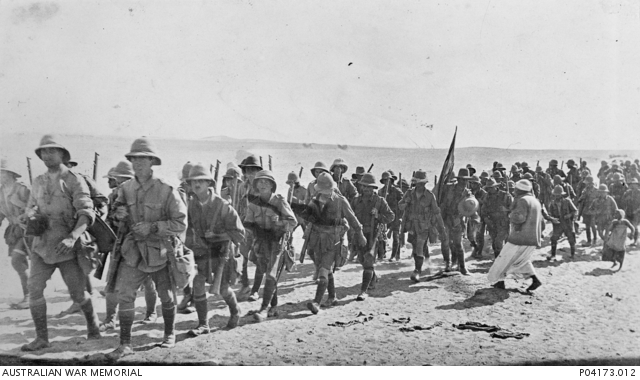
France and the Western Front
On 19 June 1916 the 54th Battalion embarked from Alexandria on the transport ship Caledonian, to join the British Expeditionary Forces in France. They arrived at Marseilles on 29 June and then immediately left for the front line at Fleurbaix.
Without any time to acquaint themselves with their surroundings, the Battalions of the 5th Division were assigned to attack the fortified German lines. This action is now known as the Battle of Fromelles. Fleurbaix and Fromelles are 5 kilometres apart, the former behind the British lines and the latter behind German lines.
According to unit orders, the 54th Battalion was assembled to attack in four waves at five-minute intervals. The first wave was to take the first German trench and clear it of the enemy. Subsequent waves of attackers were to leap-frog the first trench and take second and third German support trenches that had been identified from aerial reconnaissance. So rushed had been the planning of the attack, that there were not enough steel helmets for the third and fourth waves, who were forced to attack in their felt slouch hats.
A seven-hour long artillery bombardment of the German lines began at 11am on 19 July. The Germans, however, were aware of the troops massing in the trenches opposite, preparing to attack, and their artillery soon found their range and caused significant casualties amongst the waiting Australians.
At 5.45pm the order to attack was issued and the 54th Battalion - Albert and his mates - “hopped the bags” (went over the top). They achieved their objectives but found that the second and third German support trenches didn’t exist. They were merely shallow water-filled ditches providing them little cover from German rifles and machine guns. Nonetheless, they attempted to defend these ditches, digging into the gluey Flanders clay and filling sandbags from which to construct a parapet. Night fell at around 9pm.
At 11.45pm the Germans launched a concerted counterattack. It was at this time, at around midnight of 19 July or early in the morning of 20 July 1916, that Albert was killed. He was shot through the head. One can’t help but suspect he was one of those without a helmet. He was 28 years old.
As morning broke on 20 July, at 7.50am the Battalion was ordered to retreat. They suffered 540 casualties including 155 deaths. Albert’s body was left behind in the German lines, and he was possibly one of those Australian soldiers buried by the Germans in the mass graves at Fromelles. He has no known grave.
After the battle
When Albert was killed, his family were informed promptly. His sister, Nurse Lilly Singleton, made enquiries about the manner of his death and where he was buried. She wrote to his mate, Private Leo Boyton, who told her what he knew. Local newspaper articles also share the news of his death.
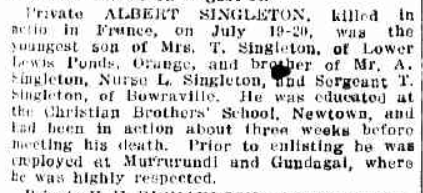
A year later in 1917, the Australian Red Cross Wounded and Missing Enquiry Bureau began looking into Albert’s death and burial. They collected eye-witness accounts from six soldiers in the 54th who had seen his death including his three friends (Privates Charles Campbell, Leo Boyton, Jack Smith) as well as Lance Corporal Horace Balcomb (4156A) and Privates Richard W. Fairweather (4198A) and Rowland J. Eyles (4192A).
Private Charlie Campbell gives the best description of Albert:
“He was of a slight build and very fair, with light curly hair and was bald on the top. He was about 5ft 10 inches in height and 26 or 27 years of age. He had very neat ways, rather sharp features.”
One of the others stated he had brown eyes, but his enlistment papers say blue. Charlie later told his Sergeant, Sgt Sydney Hill (4222), that he had lost his best friend at Fleurbaix – Albert Singleton.
And what happened to Albert’s three mates?
All three of his mates - Leo Boyton, Charlie Campbell and Jack Smith - were wounded the same evening during the Battle of Fromelles:
- 4150 Leo Milton BOYTON 1893-1962: wounded in action in the Battle of Fromelles, Leo returned to his unit on 15 October 1916. He was wounded in action at least twice more and he returned to Australia on 20 October 1918.
- 3482 Charles CAMPBELL 1895-1977: wounded in action in the Battle of Fromelles, Charlie returned to the 54th Battalion in November 1916. He survived the war and returned to Australia on 13 April 1919.
- 4311 Jack Edward SMITH (aka Lionel SCHMITZER) 1895-1918: wounded in action in the Battle of Fromelles, Jack/Lionel returned to the 54th Battalion on 15 September 1916. Jack was wounded a second time but tragically died of his wounds on 5 November 1918 and was buried in the Chichester cemetery in England.
Remembered today
Many branches of the Singleton family now remember Albert but we hope that this story will prompt many more family members to recognise the connection and to honour his memory.
Albert Leslie Singleton is commemorated on St Joseph’s Church Orange Honour Roll and on the family headstone in the Orange Cemetery. In 1923 the Anzac Memorial Avenue of trees was planted along Bathurst Road in Orange, and a tree was planted in honour of Private Singleton. His name also appears on:
- the World War I Roll of Honour on the southern face of the Orange Cenotaph,
- panel number 159 on the Roll of Honour at the Australian War Memorial in Canberra,
- panel number 11, V.C. Corner of the Australian Cemetery and Memorial at Fromelles in France, and
- the Murrurundi Shire War and Services Honour Roll, Mayne St, Murrurundi.

FAA Searching for DNA – still looking
To determine if one of the bodies recovered from the mass graves at Fromelles is that of Albert, DNA samples need to be matched to samples of DNA from Albert’s relatives. Both mitochondrial and Y chromosome DNA are needed.
So far genealogical research has located mitochondrial DNA, but no living person having the Singleton Y chromosome has been located in Australia. It is believed that no male children of Thomas fathered sons, and thus the male line appears extinguished in Australia. Unsuccessful attempts have been made to trace related Singleton family in the UK who might be able to help.
It seems that our search for Y DNA is entirely dependent on Albert’s father – and finding who his parents were and where they came from. We asked one of our FAA researchers, Carol Wordingham, to summarise the search:
- According to the registration for his death, Thomas Singleton was born in Whitehaven, England around 1818 (aged 89 at death in 1907).
- the town of Whitehaven in Cumberland has been the primary search location.
- The death certificate for Thomas Singleton states his religion as Church of England. There are two parishes in Whitehaven – St James and Holy Trinity - but there is no Thomas Singleton listed in the records of either church.
- Illegitimate baptisms were also checked and, although there were males named Thomas in the 1814-1820 timeframe, marriages can be found for the mothers and none married a Singleton.
- The 1841 census has also been checked. Whitehaven - within St Bees - consisted of 14 districts together with the House of Correction and the Infirmary but there is no entry for any “Singletons” in the whole of the districts.
Certainly, Singletons were recorded in death indexes around that time and there was quite a clan of Singletons in the Gosforth area, further down the coast. A Thomas Singleton esquire was also mentioned in the Constitution of the Grand Lodge in Whitehaven in 1768. So, we presume that he did come from the Whitehaven area.
So what research alternatives are left to confirm the early life of Thomas? We know he changed his middle name from John to Isaac. How did he get to Australia? Isaac Singleton is a common version in Cumbria and at least one Isaac Singleton arrived in Australia (1853).
On his death certificate, it is recorded that Thomas had been 52 years in New South Wales and 10 years in Victoria which means he would have arrived around 1845 aged about 27 and before the gold rush. If this information is chronologically stated, there is no record that he actually started in Victoria and ended in New South Wales as he may have travelled between the two states over the years.
Thus, Albert could have arrived in either Victoria or New South Wales. Orange Historical Society could add no further information.
He may have been one of those who headed for the gold field at Lewis Ponds, and like many miners, made a more consistent living by providing services for the miners.
Thomas was 54 when he married Margaret Cunneen who was almost 30 years younger than him. There is no evidence that he may have had a previous marriage or family.
He was very well established with a pub and butcher’s shop in 1874 at Lewis Ponds gold mining area and he had a gold lease with Richard Spencer, manager of the Ophir Mining Company, up to 1900.
As you can see, we know parts of Albert’s father’s life but many vital pieces of the jigsaw remain hidden.
Mt and most importantly, Y DNA samples are being sought for family connections to
| Soldier | Albert SINGLETON b. 1887, Lewis Ponds near Orange NSW - youngest of 8. |
| Siblings | 5 siblings survived childhood: John, Maud, Arthur, Lily, Albert. |
Notes: It is believed that no male children of Thomas fathered sons, and thus the male line appears extinguished in NSW. Whilst our search for male descendants of the Singleton family is now concentrated in England, it is possible that other members of the Singleton family emigrated to NSW. Please contact Royce Atkinson, Fromelles Association on royce@fromelles.info if you can help.
| Parents | Thomas John / Isaac SINGLETON 1818-1907, and Margaret CUNNEEN 1847-1929 |
Notes: John was an earlier middle name recorded and then changed to Isaac in later documents. Thomas was born in Whitehaven, Cumberland (extract: death certificate). Margaret was born in Kilnasoolagh, County Clare, Ireland. They married in Orange in 1872.
| Grandparents | |||
| Paternal | Thomas SINGLETON from Cumbria UK. | ||
| Maternal | Cunneen family from Ireland (descendants have been found) |
The Fromelles Association would love to hear from you

Contacts
(Contact: royce@fromelles.info or geoffrey@fromelles.info).
(Contact: army.uwc@defence.gov.au or phone 1800 019 090).
Donations
If you are able, please contribute to the upkeep of this resource.
(Contact: bill@fromelles.info ).

